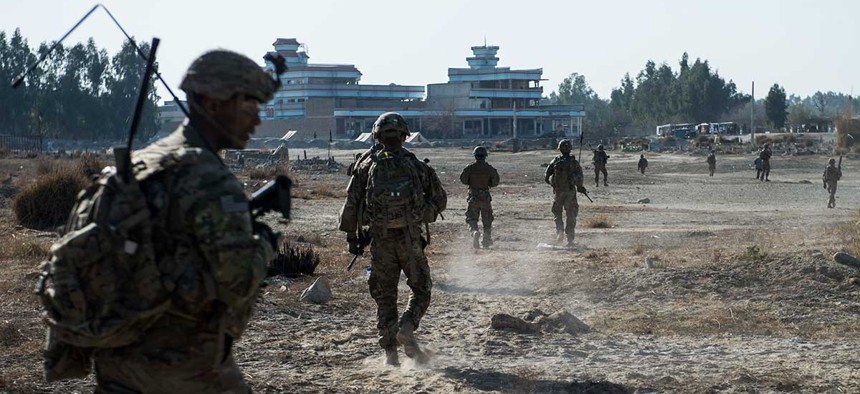
Soldiers assigned to the 10th Mountain Division walk on a dismounted patrol outside of Camp Fenty, Afghanistan in 2016. Staff Sgt. Corey Hook/Army file photo
Ordered to Ban Transgender Troops, Pentagon Plans A New Look at Three Factors
The courts will take their own look, thanks to a trio of lawsuits filed in the wake of Trump’s Friday-night memo.
The Pentagon will take its own look into the questions of how, if at all, transgender troops affect unit cohesion, readiness and lethality, and resource levels — the three factors that the White House says it should consider before re-allowing transgender people to serve openly.
Those are the metrics President Donald Trump outlined in a policy directive he sent to the Defense Department and Department of Homeland Security late Friday afternoon. That directive was the official follow-up to a string of bombshell tweets in which Trump announced he was reinstating a ban on trans troops that the Pentagon had walked away from in July 2016.
Trump’s directive allows Defense Secretary Jim Mattis some leeway to deciding whether current transgender servicemembers can stay, but bans future recruits and prohibits the department from paying for troops’ gender reassignment surgery.
Mattis would have to return to the president with a “convincing” case that “a change to the policy is warranted,” the order says.
Before overturning the ban last year, then-Defense Secretary Ash Carter conducted a working group and commissioned a Rand Corporation study to evaluate “the policy and readiness implications of welcoming transgender persons to serve openly.” That study found that allowing trans troops would cost little and would have “no significant impact on unit cohesion or operational readiness.”
But the Pentagon now is re-examining those questions as it starts developing guidance for the services to implement Trump’s order.
“It’s too soon” to have answers about whether openly serving trans troops adversely affect readiness, lethality or unity cohesion, but “that is one of the things that will be looked at as we move forward,” Pentagon spokesperson Col. Robert Manning said.
“We’re very early in the process; we just got the guidance,” Manning said Monday. “We’re at a point right now where we have to provide the services interim guidance and then provide implementation guidance six months from now.”
That also means the Pentagon will look to more conclusively establish the number of trans troops currently serving and their associated medical costs. The Rand study offered a “mid-range estimate” of just under 4,000 active and reserve trans troops, though some studies suggest there may be as many as 15,000. That’s still a tiny fraction of the military’s 1.3 million personnel.
“We just haven’t gotten there yet, but that’s what’s going to be looked [at], as part of the implementation guidance — that deeper look,” Manning said.
Multiple lawsuits, however, could slow that implementation. As the courts opened Monday morning, the American Civil Liberties Union filed suit on behalf of five transgender servicemembers. It and another suit filed by Lambda Legal and OutServe-SLDN, a non-profit providing legal services to troops affected by Don’t Ask Don’t Tell, both argue the ban is discriminatory and unconstitutional. These two cases join a similar one filed by five trans troops earlier this month in response to the president’s tweets.
Manning said the Pentagon does not comment on ongoing litigation.







